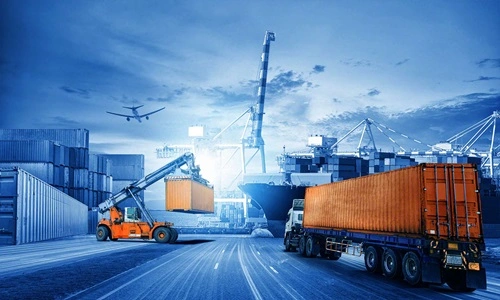The logistics industry is undergoing rapid transformation, driven by digitalization, automation, and sustainability efforts according to 2025. The global logistics market is projected to grow at a CAGR of 6.8%, fueled by the expansion of e-commerce, supply chain optimization, and the integration of AI and IoT.
In India, logistics companies such as Delhivery, Blue Dart, and Mahindra Logistics are investing heavily in technology-driven solutions to improve efficiency. The adoption of warehouse automation, predictive analytics, and blockchain-based tracking systems is enhancing supply chain transparency and reducing costs.
The government’s Gati Shakti initiative and National Logistics Policy (NLP) are further streamlining infrastructure and regulatory frameworks, reducing logistics costs from 14% to 10% of GDP. Companies are also prioritizing sustainable logistics, with a push towards electric vehicles (EVs) for last-mile delivery and green warehousing solutions.
With increased foreign investments and tech-driven advancements, the logistics sector in 2025 is poised for robust growth and efficiency improvements and here on this page we will discuss in-depth about SWOT Analysis of Logistic Company in India.
Strengths:
1. Robust Market Growth: The Indian logistics market is on a strong growth trajectory, with projections indicating an increase from USD 427.73 billion in 2024 to approximately USD 756.72 billion by 2034, reflecting a compound annual growth rate (CAGR) of 6.5%.
2. Government Initiatives and Infrastructure Development: The Government of India has prioritized infrastructure development, earmarking approximately $1.4 trillion for investment by 2025. This includes significant enhancements in roads, highways, and ports, facilitating more efficient transportation and logistics operations.
3. Advancements in Digitalization: The logistics sector is embracing digital technologies such as Artificial Intelligence (AI), the Internet of Things (IoT), and blockchain to improve operational efficiency, transparency, and customer satisfaction. These advancements are transforming traditional logistics into more agile and responsive supply chains.
4. Expansion of E-commerce: The Indian e-commerce industry is projected to reach $100 billion by 2025, driving demand for efficient logistics solutions, particularly in last-mile delivery and fulfillment services. This growth is fostering innovation and investment within the logistics sector.

Weaknesses:
1. Fragmented Market Structure: The Indian logistics industry is highly fragmented, with numerous small and unorganized players leading to inefficiencies, lack of standardization, and challenges in scalability. This fragmentation hampers the ability to provide integrated and seamless logistics solutions.
2. High Logistics Costs: Logistics costs in India account for a significant percentage of the GDP, higher than in developed economies. Factors contributing to this include suboptimal modal mix, infrastructural bottlenecks, and regulatory complexities, which collectively impact the competitiveness of Indian goods in global markets.
3. Regulatory Challenges: Despite reforms, the logistics sector still faces regulatory hurdles, including complex compliance requirements and varying state-level policies, which can lead to delays and increased operational costs. Streamlining these regulations remains a critical area for improvement.
Opportunities:
1. Investment in Technology and Innovation: There is a significant opportunity for logistics companies to invest in technology-driven solutions, such as automation, real-time tracking, and data analytics, to enhance efficiency and customer service. Adopting these technologies can lead to more responsive and resilient supply chains.
2. Development of Multimodal Logistics Parks: The government’s focus on developing multimodal logistics parks aims to integrate various modes of transport, reduce logistics costs, and improve supply chain efficiency. These parks are expected to serve as hubs that facilitate seamless movement of goods across different transportation modes.
3. Growth in Contract Logistics: The contract logistics market in India is expected to reach USD 160.88 billion in 2025 and grow at a CAGR of over 8.71% to reach USD 244.26 billion by 2030. This growth presents opportunities for logistics companies to offer specialized services and integrated supply chain solutions.
4. Sustainable and Green Logistics: With increasing environmental awareness, there is a growing demand for sustainable logistics practices. Companies adopting eco-friendly measures, such as alternative fuels and energy-efficient warehouses, can gain a competitive advantage and meet regulatory standards.
Threats:
1. Intensifying Competition: The logistics sector is witnessing increased competition, both from established players expanding their services and new entrants leveraging technology-driven models. This heightened competition can lead to margin pressures and necessitates continuous innovation.
2. Economic Fluctuations: Global and domestic economic uncertainties can impact trade volumes, affecting the demand for logistics services. Economic downturns may lead to reduced consumer spending and industrial production, directly influencing the logistics industry.
3. Infrastructure Bottlenecks: Despite ongoing investments, certain infrastructural challenges persist, such as port congestion, inadequate rural connectivity, and limited warehousing facilities, which can disrupt supply chains and increase operational costs.
4. Regulatory Compliance and Policy Changes: Frequent changes in regulations and policies can create uncertainty and require logistics companies to adapt swiftly, incurring additional compliance costs and operational adjustments. Staying abreast of policy developments is essential to mitigate this threat.
Conclusion:
In 2025, India’s logistics industry is poised for substantial growth, underpinned by government initiatives, technological advancements, and the expanding e-commerce sector. However, to fully realize this potential, it is imperative to address existing weaknesses such as market fragmentation and high logistics costs. By capitalizing on opportunities in technology adoption, infrastructure development, and sustainable practices, while proactively mitigating threats from competition and economic fluctuations, the logistics sector can evolve into a more efficient, integrated, and resilient component of India’s economic framework.
Anantha Nageswaran is the chief editor and writer at TheBusinessBlaze.com. He specialises in business, finance, insurance, loan investment topics. With a strong background in business-finance and a passion for demystifying complex concepts, Anantha brings a unique perspective to his writing.


